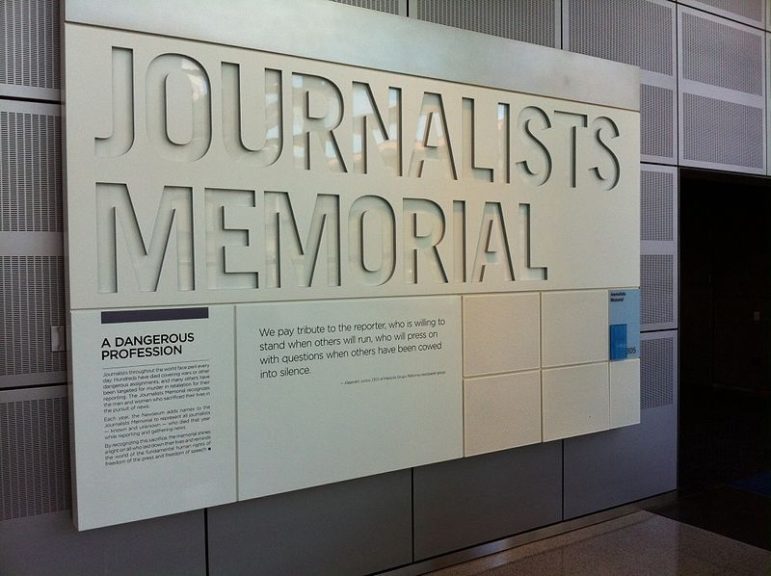
Last week, NPR announced the tragic death of their colleague photojournalist David Gilkey and his interpreter Zabihullah Tamanna in Afghanistan after their vehicle was hit by rocket grenades. Gilkey’s death reminded the journalism community of the increasingly precarious nature of reporting from conflict zones. On Monday, June 6th, Newseum, a museum dedicated to issues of free speech and the First Amendment, rededicated its Journalists Memorial, which honors slain journalists, with another unfortunate crop of names joining the list of the fallen. Only a day after the rededication, protestors would figuratively bombard a Newseum event, asking why the museum had invited Lt. Col. Avital Leibovich, a former Israeli Defense Forces official and spokesperson, to speak when she has previously justified the targeted killing of Palestinian journalists.
While in some circumstances journalists are the victims of the random violence of the conflicts they are reporting on, as seen in Gilkey’s case, other times journalists find themselves the targets in the conflicts by governments and rebel organizations. In these areas, journalists volley between being considered innocent civilians and active participants of the conflict themselves, as we saw in Baghdad. This was true in the controversial killings of two Palestinian journalists, Mahmoud al-Kumi and Hussam Salama, who worked for a Hamas-affiliated television station and were killed in an airstrike by the Israeli Defense Forces in 2012.
Israel acknowledged that the airstrikes specifically targeted the two journalists, who worked as cameramen for Hamas-run station Al-Aqsa. At the time of their killings, Lt. Col. Avital Leibovich, who controversially came to speak at Newseum this week on an unrelated topic, told the Associated Press the men were believed to be Hamas operatives, without providing any further elaboration. She also defended IDF’s actions in a letter to the editor, saying, “Such terrorists, who hold cameras and notebooks in their hands, are no different from their colleagues who fire rockets aimed at Israeli cities and cannot enjoy the rights and protection afforded to legitimate journalists.” Based on Leibovich’s own illustration of the attack in this letter, the journalists were targeted because of their affiliation to the news organization, not because of terrorist activity they themselves had partaken in.
Almost immediately, her comments and the killings sparked outrage among advocacy groups, who recognized the men as journalists. The Committee to Protect Journalists and Reporters Without Borders (RWB) both seriously questioned the legal ramifications of targeting civilian journalists. RWB accused Israel of targeting journalists once again, as in 2014. Human Rights Watch said, “Civilian broadcasting facilities are not rendered legitimate military targets simply because they broadcast pro-Hamas or anti-Israel propaganda.”
Sign up for our free newsletters
Subscribe to NPQ's newsletters to have our top stories delivered directly to your inbox.
By signing up, you agree to our privacy policy and terms of use, and to receive messages from NPQ and our partners.
As such, Newseum has been caught in the middle of an ethical conundrum since the 2012 killings. As mentioned, the museum honors slain journalists both digitally through an online database and with a physical commemoration on the Journalists Memorial, which includes the names of the slain journalists and is rededicated annually. When the names of al-Kumi and Salama were added to the memorial, there was uproar from the Israeli government, as well as from the Anti-Defamation League and the American Jewish Committee as well, alleging the journalists should be considered terrorists because of the station’s affiliation with Hamas. Newseum buckled under pressure and removed the names from their online database. After careful consideration of whether the journalists could be classified as terrorists, the names were added back to the database and are still on the Journalists Memorial.
However, as seen with the protests at Leibovich’s speaking at Newseum, the issue is far from over. While the presentation focused on social media use in war zones, protesters and some questions from the audience were quick to the refocus the conversation on Leibovich’s comments four years ago. One questioner asked, “Why did the Newseum, as an institution dedicated to freedom of the press, think it’s a good idea to invite someone who justifies and murdered two people who you recognize were slain journalists in the line of duty?” The Intercept asked whether Leibovich agreed with the museum’s decision to include the journalists on their memorial, a question which she did not answer.
In response to their decision to invite Leibovich, which was protested by the advocacy group Palestinian Journalists Syndicate, Newseum CEO Jeffery Herbst said, “The Newseum has a bedrock commitment to free speech and free expression. We believe that this is the only approach possible to understanding the complex issues we face. That is also why we hold public discussions on important issues.”
While protestors may be well intentioned, Herbst is right. Indeed, it would in fact violate Newseum’s principles to prevent Leibovich from speaking at the organization. The First Amendment honors speech from the fringes of society to the mainstream to facilitate true discussion. However, to our knowledge, Newseum has not held a public forum, such as this event, to give the public and the media a chance to speak to Leibovich and officials from the museum to question them directly. We ask the Newseum to provide the opportunity to speak to Leibovich, if she would like to answer to the killings, as a genuine show of commitment to their principles.
As the Israel-Palestine conflict persists and journalists continue to report from other conflicts around the world, this is an issue that will likely persist. If nothing else, a transparent discussion with the museum’s officials on their decision to include the Palestinian journalists would be a productive way to help all understand these complex issues.—Shafaq Hasan












